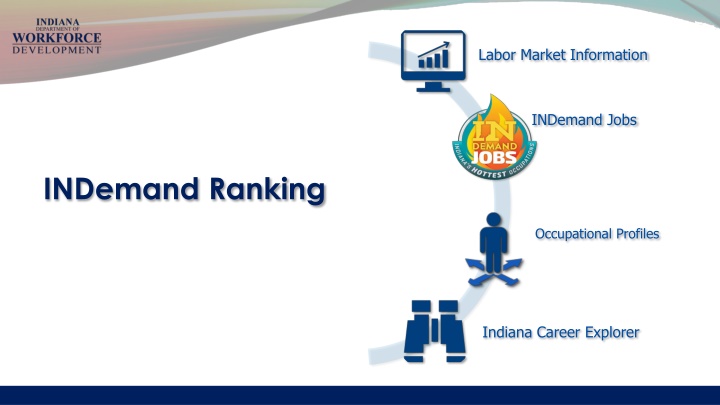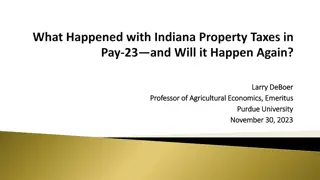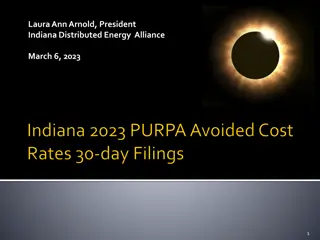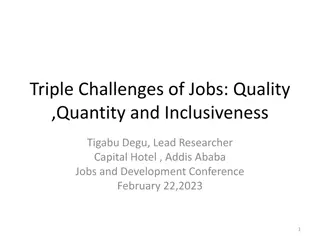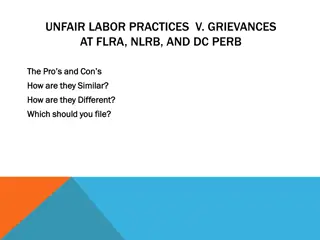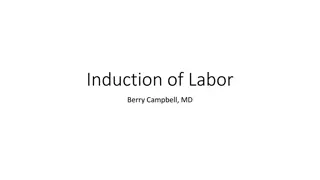Indiana INDemand Jobs and Labor Market Information
Indiana INDemand Jobs are determined based on future demand, percent change, wages, and real-time labor market data. The ranking methodology includes short-term and long-term projections, with a scoring system for each occupation. The Decile Ranking Method assigns scores from 1-10 in various categories to provide a composite ranking for each occupation in Indiana. Key factors such as projected openings, growth percentage change, and wages influence the final rankings.
Download Presentation

Please find below an Image/Link to download the presentation.
The content on the website is provided AS IS for your information and personal use only. It may not be sold, licensed, or shared on other websites without obtaining consent from the author.If you encounter any issues during the download, it is possible that the publisher has removed the file from their server.
You are allowed to download the files provided on this website for personal or commercial use, subject to the condition that they are used lawfully. All files are the property of their respective owners.
The content on the website is provided AS IS for your information and personal use only. It may not be sold, licensed, or shared on other websites without obtaining consent from the author.
E N D
Presentation Transcript
Labor Market Information INDemand Jobs INDemand Ranking Occupational Profiles Indiana Career Explorer
INDemand Jobs are based on future demand, percent change, wages, and real time labor market information
Projection inputs include state and national variables State level Covered and non-covered employment time series Variables, i.e. Labor Force, Initial claims, Indiana leading index, Personal Income, Population, etc Occupation staffing ratios per industry Economic development activity National level National occupation-specific change and utilization rates by industry, i.e, effects from automation, robotics, offshoring, technology, etc. National Projections Variables, i.e. GDP, United States Labor Productivity, Prime interest rate %, Housing Starts, etc Occupational Projections Occupational projections are produced at the state level within a national consortium, The Projections Managing Partnership is funded by the U.S. Employment and Training Administration. Indiana is represented on the PMP Board.
INDemand Ranking Methodology Inputs Short Term Total Projected Openings (33.33%) Short Term Growth Openings (16.67%) Short Term Percentage Change (16.67%) Job Postings (16.67%) Wages* (16.67%) Long Term Total Projected Openings (40%) Long Term Growth Openings (20%) Long Term Percentage Change (20%) Wages* (20%) Long Term Score Short Term Score Average Score = INDemand Ranking *As to wages, any occupation scoring 3 or 4 in the wage category cannot score higher than 3 Flames and any occupation scoring 1 or 2 in the wage category cannot score higher than 2 Flames. (Source: National Wages were used for occupations with wages suppressed in Indiana)
INDemand Decile Ranking Method For both short term projections and long term projections, each occupation is assigned a 1-10 score in each of the five categories by ranking how it performs in comparison to every other occupation in Indiana. The scoring method is determined by deciles, or in other words, a percentile system ranging from the 90th percentile and above, down to the 10th percentile and below. The score is weighted by category for both the short term and long term projected outlooks and then averaged to provide a final composite score. Registered Nurse 29-1141 Total Projected Openings Short Term Ranking Total Projected Openings X2 Growth Percent Change Wages Real Time LMI 10 10 9 8 10 9.5 Job Growth Openings Postings Short Term Final Score Long Term Ranking Total Projected Openings X2 Growth Percent Change Wages 10 10 9 8 % Wage Change Long Term Final Score 9.4 Flame Ranking *As to wages, any occupation scoring 3 or 4 in the wage category cannot score higher than 3 Flames and any occupation scoring 1 or 2 in the wage category cannot score higher than 2 Flames. (Source: National Wages were used for occupations with wages suppressed in Indiana)
Whats Included? Whats Not? Real time labor market analytics Short and long term future projected demand Rate of growth Number of growth openings Occupational change rates due to automation, changes in business practices, technological innovation, mergers & outsourcing Economic development activity Labor force projections Wages Education attainment or training value Job vacancy or skills gap surveys Supply vs demand gap Number of openings threshold Skills/Competencies
Real Time Labor Market Information Real time labor market information is used to help understand local labor market patterns and opportunities Burning Glass Technologies is the leading source for Real Time LMI Codes millions of job postings from more than 40,000 online sources daily
INDemand Ranking: Policy & Decision Making NextLevel Jobs Eligible Training Providers Career Technical Education
HOW DO STATES MEASURE IN DEMAND JOBS? 80% - projected job openings More states took an ordinal approach, ranking occupations by number of projected job openings, than taking a cardinal approach (only looking at occupations with at least 1,000 projected job openings, for example) 69% - growth rate from employment projections 51% - online job ads 31% - targeted industries 29% - supply and demand analysis 22% - job vacancy, skills gap, or other employer surveys Note: 63% use a composite method of more than one metric Source: Bureau of Labor Statistics State Survey, 2017
HOW DO STATES MEASURE IN DEMAND JOBS? States refine their lists with certain metrics: 75% - occupational wages Usually mean or median OES wage for the state 53% - education and training levels Some states have several lists of jobs in demand covering different levels 24% - base year minimum employment cutoff 22% - projected number of new jobs Results of the BLS survey (Continued)
OTHER FORMULA SCENARIOS DOUBLE OPENINGS (IN) NO WEIGHT - BASELINE DOUBLE WAGES Ratings driver: 1. Growth 2. Percentage Change 3. Total Openings 4. Wages 5. Burning Glass Job Postings (only short term) Educational attainment and OES wages All categories equally Demand and projections data (with projections / demand data taking a precedence because it has more categories in the formula) (due to the correlation between higher education and higher wages) Number of 5-flame occupations 16 12 16 5-flame occupations in No weight (baseline) that are not scoring 5 flames in other categories Personal Financial Advisors Occupational Therapists N/A All Number of advanced degree 5-flame occupations 3 4 5
OTHER FORMULA SCENARIOS OUTCOMES Double weighting OPENINGS Current methodology 90% occupations within 5 flame occupations were in the 75th percentile or above of wages Wage rule prevents high churn, low pay occupations from elevating to 4 or 5 flame occupations Current wage rule prevents low wage, high demand occupations from elevating on the ranking list Double weighting the openings (to highlight high demand occupations within a range of education attainment level categories) elevated occupations requiring more than a high diploma Post-secondary certificates are best represented by the current double-weighted demand method. Indiana would lose four 5 flame post-secondary certificate openings by moving to the single weighted opening methodology, and all post-secondary certificates are removed from the 5 flame category when using the double weighted wage method. Double weighting WAGES Bias towards Bachelor s and even Master s degree requirements De-emphasizes jobs with an Associate s degree, Certificate, or less, especially impacting Healthcare occupations, where the need is great May misrepresent demand on EGR level rankings (some EGRs do not have a robust representation in key industries there would be misrepresentation of the demand when wage is driving the rankings, especially at the regional level) Single weighting DEMAND Equals a definite opportunity for job seekers Water down demand opportunities by volume, but would be more holistic in terms of varying education attainment levels than double weight of wages
Contact Information Contact Information Fran Valentine Fran Valentine Sr. Director, Research Analysis & Engagement Indiana Department of Workforce Development Fvalentine1@dwd.in.gov Fvalentine1@dwd.in.gov
